CHC30113 Cert III Early Childhood Education CHCECE005 Assessment
VerifiedAdded on 2023/06/18
|38
|8590
|277
Homework Assignment
AI Summary
This assignment solution pertains to CHCECE005 Provide care for babies and toddlers, a unit within the CHC30113 Certificate III in Early Childhood Education and Care. It addresses key areas such as understanding and mitigating the risks of SUDI (Sudden Unexpected Death in Infancy) through safe sleep practices for educators. The assignment also covers interpreting infant cues related to feelings, wants, and needs, along with outlining the correct steps for nappy changing to prevent the spread of disease. Furthermore, it emphasizes the importance of maintaining clean bedding for children during rest and sleep times and discusses the rationale behind feeding babies individually. The document provides detailed answers and resubmission responses, highlighting the iterative feedback process and improvements made based on assessor comments.
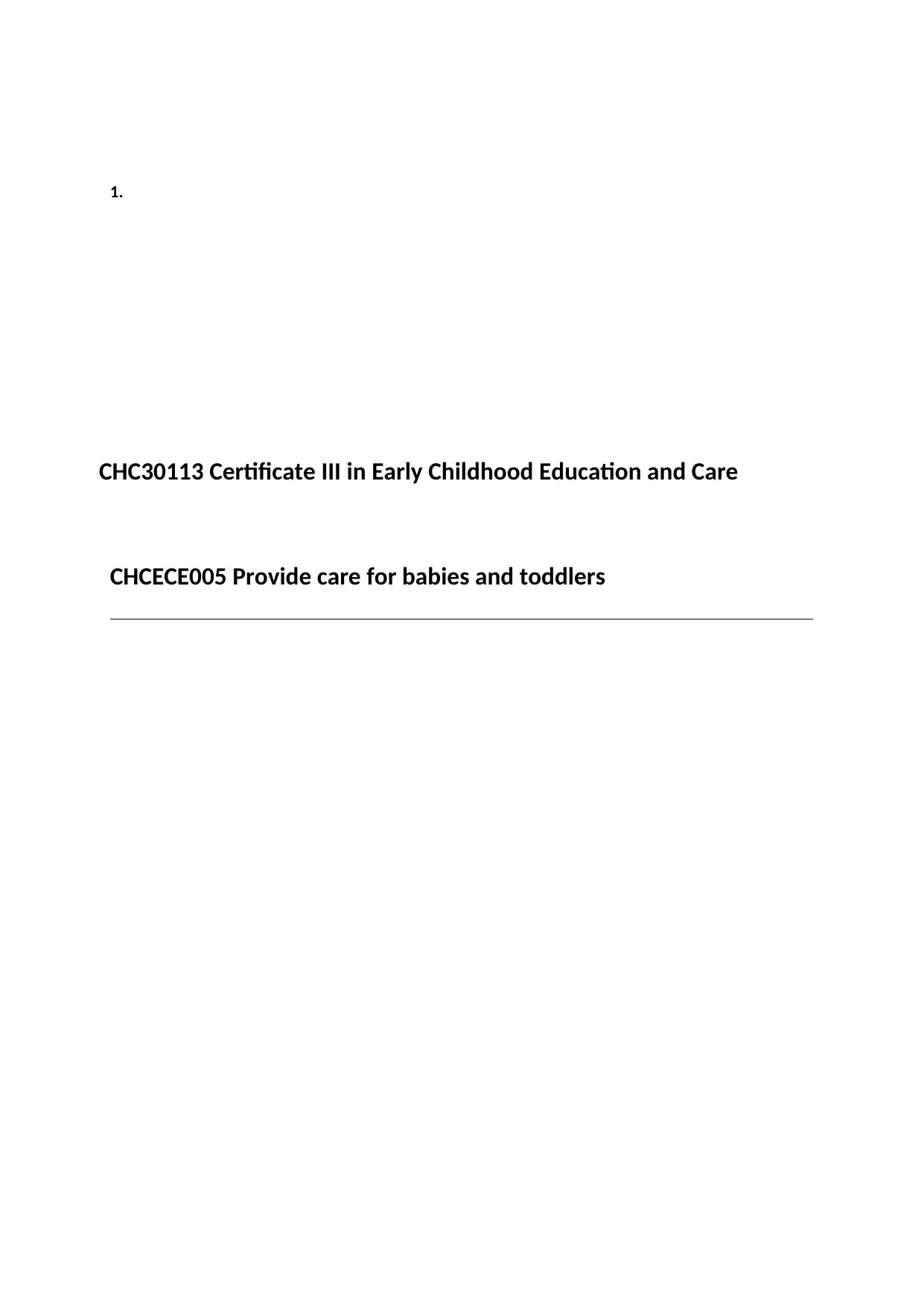
1.
CHC30113 Certificate III in Early Childhood Education and Care
CHCECE005 Provide care for babies and toddlers
CHC30113 Certificate III in Early Childhood Education and Care
CHCECE005 Provide care for babies and toddlers
Paraphrase This Document
Need a fresh take? Get an instant paraphrase of this document with our AI Paraphraser

.
2
2
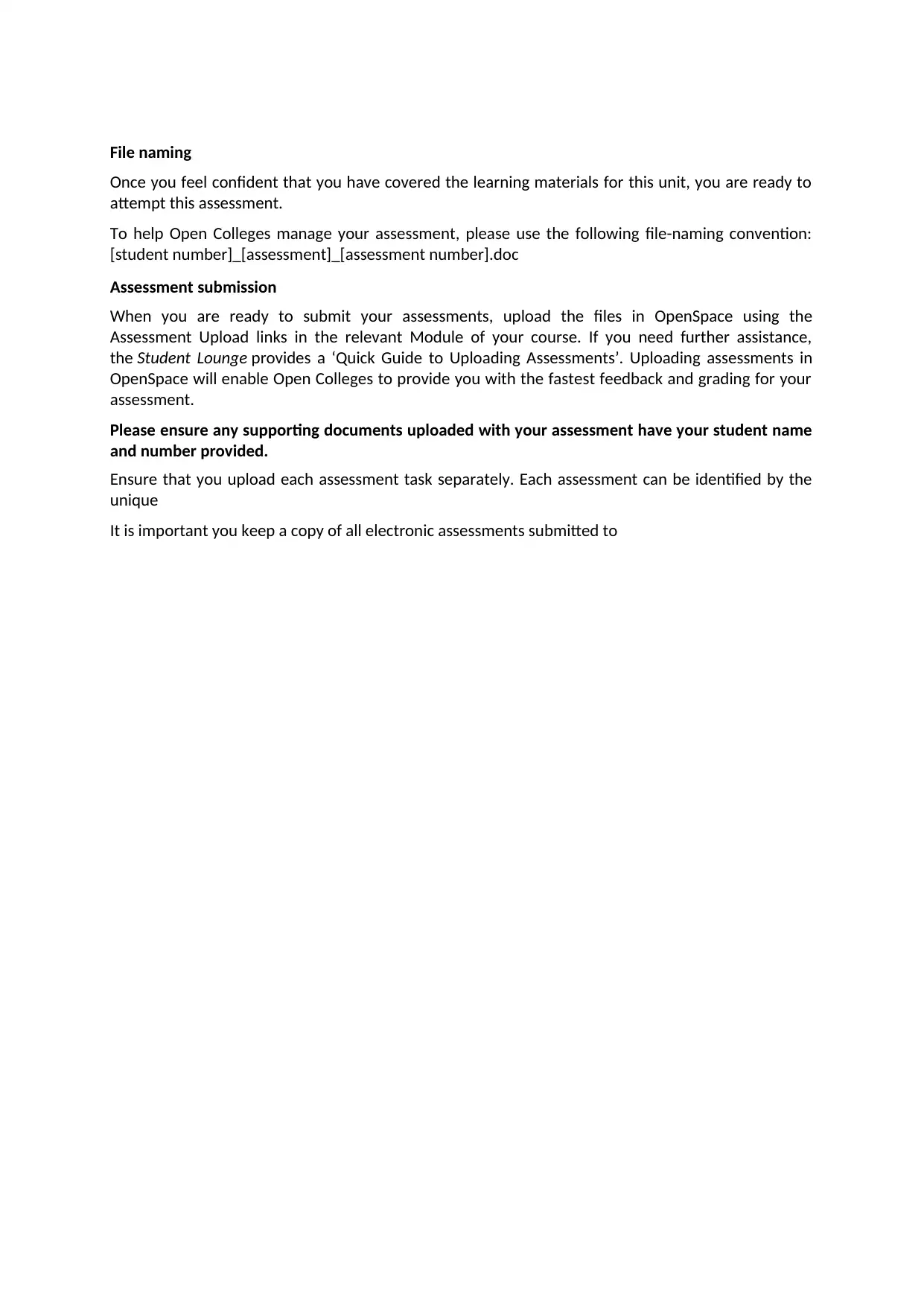
File naming
Once you feel confident that you have covered the learning materials for this unit, you are ready to
attempt this assessment.
To help Open Colleges manage your assessment, please use the following file-naming convention:
[student number]_[assessment]_[assessment number].doc
Assessment submission
When you are ready to submit your assessments, upload the files in OpenSpace using the
Assessment Upload links in the relevant Module of your course. If you need further assistance,
the Student Lounge provides a ‘Quick Guide to Uploading Assessments’. Uploading assessments in
OpenSpace will enable Open Colleges to provide you with the fastest feedback and grading for your
assessment.
Please ensure any supporting documents uploaded with your assessment have your student name
and number provided.
Ensure that you upload each assessment task separately. Each assessment can be identified by the
unique
It is important you keep a copy of all electronic assessments submitted to
Once you feel confident that you have covered the learning materials for this unit, you are ready to
attempt this assessment.
To help Open Colleges manage your assessment, please use the following file-naming convention:
[student number]_[assessment]_[assessment number].doc
Assessment submission
When you are ready to submit your assessments, upload the files in OpenSpace using the
Assessment Upload links in the relevant Module of your course. If you need further assistance,
the Student Lounge provides a ‘Quick Guide to Uploading Assessments’. Uploading assessments in
OpenSpace will enable Open Colleges to provide you with the fastest feedback and grading for your
assessment.
Please ensure any supporting documents uploaded with your assessment have your student name
and number provided.
Ensure that you upload each assessment task separately. Each assessment can be identified by the
unique
It is important you keep a copy of all electronic assessments submitted to
⊘ This is a preview!⊘
Do you want full access?
Subscribe today to unlock all pages.

Trusted by 1+ million students worldwide
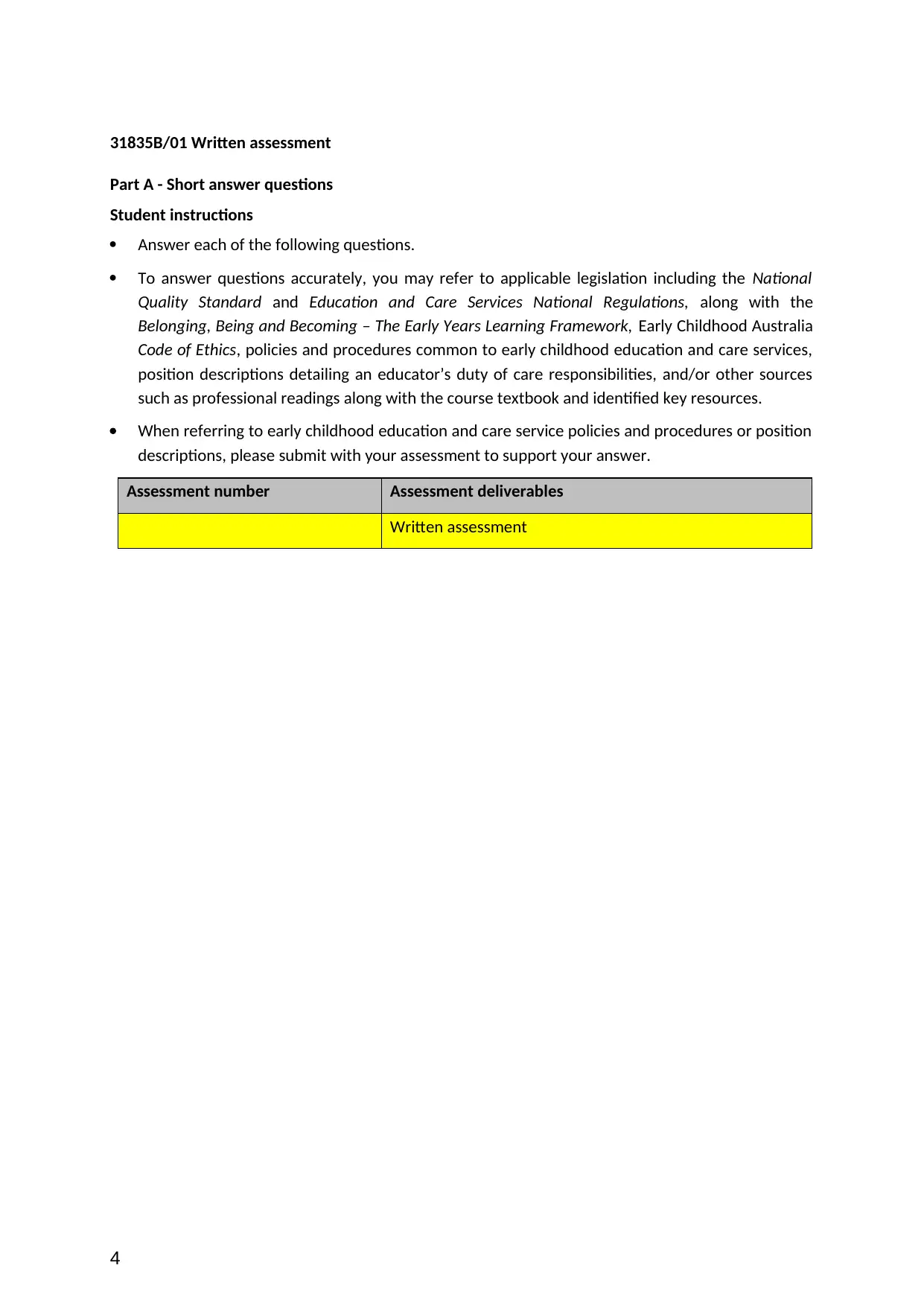
31835B/01 Written assessment
Part A - Short answer questions
Student instructions
Answer each of the following questions.
To answer questions accurately, you may refer to applicable legislation including the National
Quality Standard and Education and Care Services National Regulations, along with the
Belonging, Being and Becoming – The Early Years Learning Framework, Early Childhood Australia
Code of Ethics, policies and procedures common to early childhood education and care services,
position descriptions detailing an educator’s duty of care responsibilities, and/or other sources
such as professional readings along with the course textbook and identified key resources.
When referring to early childhood education and care service policies and procedures or position
descriptions, please submit with your assessment to support your answer.
Assessment number Assessment deliverables
Written assessment
4
Part A - Short answer questions
Student instructions
Answer each of the following questions.
To answer questions accurately, you may refer to applicable legislation including the National
Quality Standard and Education and Care Services National Regulations, along with the
Belonging, Being and Becoming – The Early Years Learning Framework, Early Childhood Australia
Code of Ethics, policies and procedures common to early childhood education and care services,
position descriptions detailing an educator’s duty of care responsibilities, and/or other sources
such as professional readings along with the course textbook and identified key resources.
When referring to early childhood education and care service policies and procedures or position
descriptions, please submit with your assessment to support your answer.
Assessment number Assessment deliverables
Written assessment
4
Paraphrase This Document
Need a fresh take? Get an instant paraphrase of this document with our AI Paraphraser
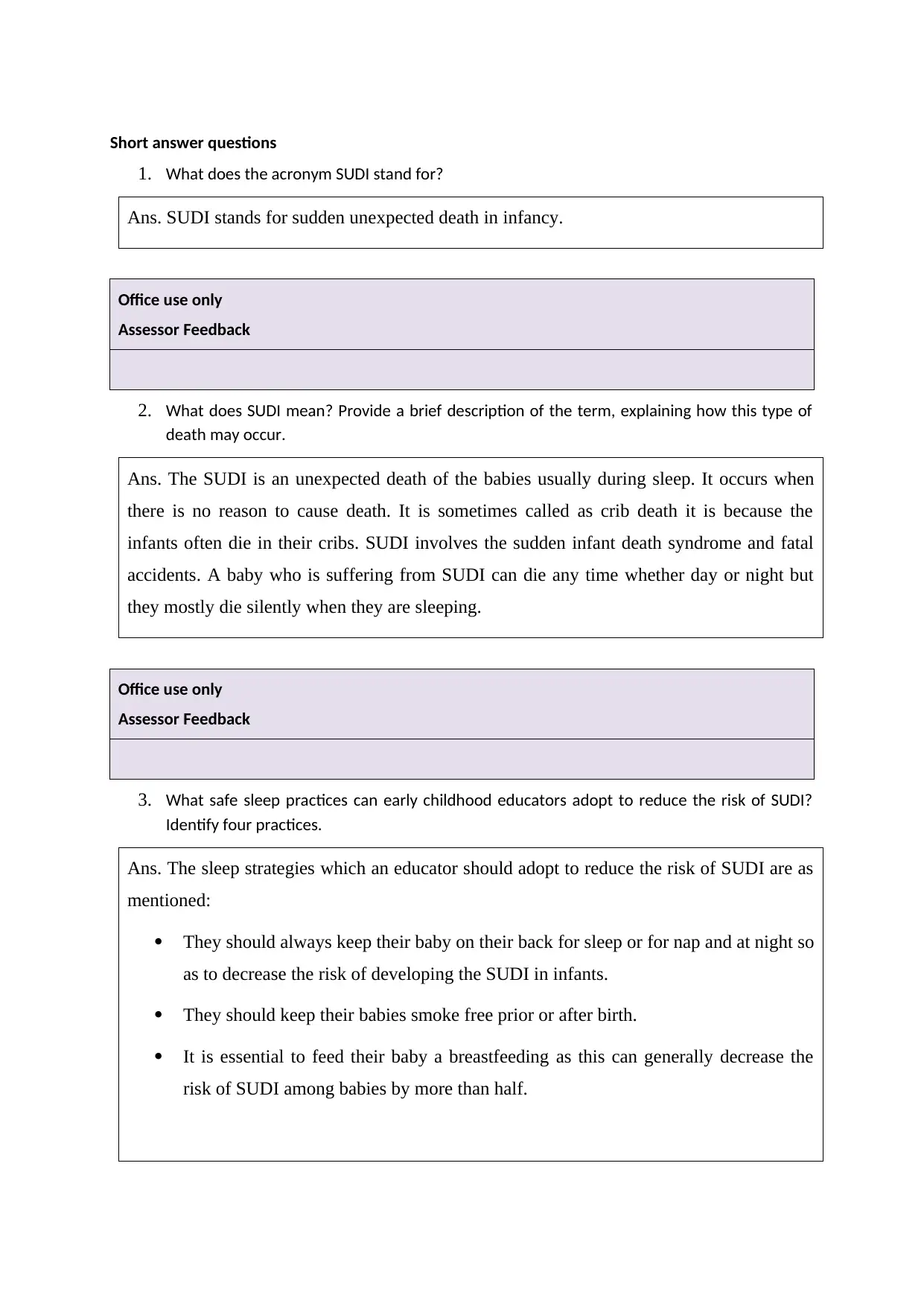
Short answer questions
1. What does the acronym SUDI stand for?
Ans. SUDI stands for sudden unexpected death in infancy.
Office use only
Assessor Feedback
2. What does SUDI mean? Provide a brief description of the term, explaining how this type of
death may occur.
Ans. The SUDI is an unexpected death of the babies usually during sleep. It occurs when
there is no reason to cause death. It is sometimes called as crib death it is because the
infants often die in their cribs. SUDI involves the sudden infant death syndrome and fatal
accidents. A baby who is suffering from SUDI can die any time whether day or night but
they mostly die silently when they are sleeping.
Office use only
Assessor Feedback
3. What safe sleep practices can early childhood educators adopt to reduce the risk of SUDI?
Identify four practices.
Ans. The sleep strategies which an educator should adopt to reduce the risk of SUDI are as
mentioned:
They should always keep their baby on their back for sleep or for nap and at night so
as to decrease the risk of developing the SUDI in infants.
They should keep their babies smoke free prior or after birth.
It is essential to feed their baby a breastfeeding as this can generally decrease the
risk of SUDI among babies by more than half.
1. What does the acronym SUDI stand for?
Ans. SUDI stands for sudden unexpected death in infancy.
Office use only
Assessor Feedback
2. What does SUDI mean? Provide a brief description of the term, explaining how this type of
death may occur.
Ans. The SUDI is an unexpected death of the babies usually during sleep. It occurs when
there is no reason to cause death. It is sometimes called as crib death it is because the
infants often die in their cribs. SUDI involves the sudden infant death syndrome and fatal
accidents. A baby who is suffering from SUDI can die any time whether day or night but
they mostly die silently when they are sleeping.
Office use only
Assessor Feedback
3. What safe sleep practices can early childhood educators adopt to reduce the risk of SUDI?
Identify four practices.
Ans. The sleep strategies which an educator should adopt to reduce the risk of SUDI are as
mentioned:
They should always keep their baby on their back for sleep or for nap and at night so
as to decrease the risk of developing the SUDI in infants.
They should keep their babies smoke free prior or after birth.
It is essential to feed their baby a breastfeeding as this can generally decrease the
risk of SUDI among babies by more than half.
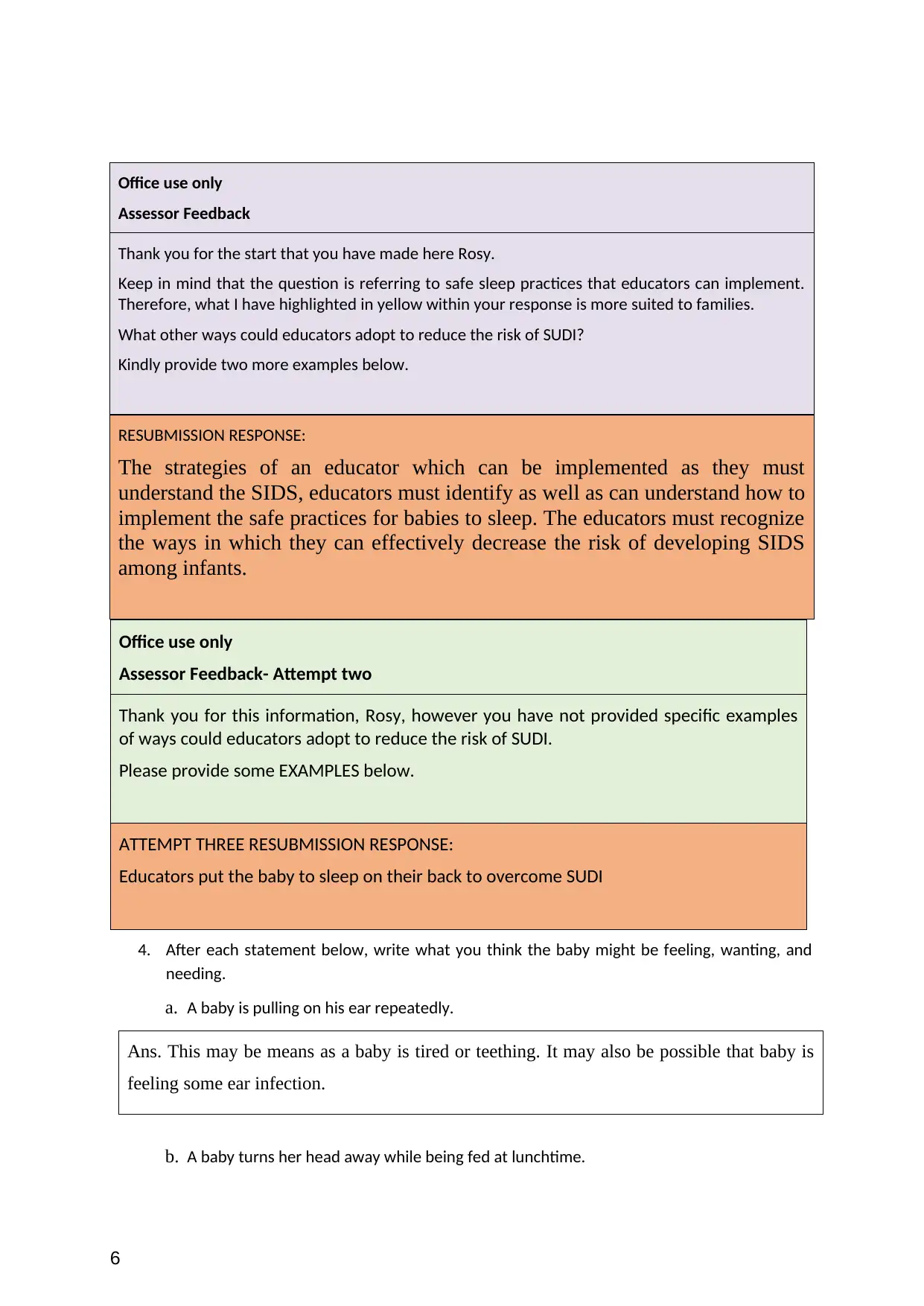
Office use only
Assessor Feedback
Thank you for the start that you have made here Rosy.
Keep in mind that the question is referring to safe sleep practices that educators can implement.
Therefore, what I have highlighted in yellow within your response is more suited to families.
What other ways could educators adopt to reduce the risk of SUDI?
Kindly provide two more examples below.
RESUBMISSION RESPONSE:
The strategies of an educator which can be implemented as they must
understand the SIDS, educators must identify as well as can understand how to
implement the safe practices for babies to sleep. The educators must recognize
the ways in which they can effectively decrease the risk of developing SIDS
among infants.
Office use only
Assessor Feedback- Attempt two
Thank you for this information, Rosy, however you have not provided specific examples
of ways could educators adopt to reduce the risk of SUDI.
Please provide some EXAMPLES below.
ATTEMPT THREE RESUBMISSION RESPONSE:
Educators put the baby to sleep on their back to overcome SUDI
4. After each statement below, write what you think the baby might be feeling, wanting, and
needing.
a. A baby is pulling on his ear repeatedly.
Ans. This may be means as a baby is tired or teething. It may also be possible that baby is
feeling some ear infection.
b. A baby turns her head away while being fed at lunchtime.
6
Assessor Feedback
Thank you for the start that you have made here Rosy.
Keep in mind that the question is referring to safe sleep practices that educators can implement.
Therefore, what I have highlighted in yellow within your response is more suited to families.
What other ways could educators adopt to reduce the risk of SUDI?
Kindly provide two more examples below.
RESUBMISSION RESPONSE:
The strategies of an educator which can be implemented as they must
understand the SIDS, educators must identify as well as can understand how to
implement the safe practices for babies to sleep. The educators must recognize
the ways in which they can effectively decrease the risk of developing SIDS
among infants.
Office use only
Assessor Feedback- Attempt two
Thank you for this information, Rosy, however you have not provided specific examples
of ways could educators adopt to reduce the risk of SUDI.
Please provide some EXAMPLES below.
ATTEMPT THREE RESUBMISSION RESPONSE:
Educators put the baby to sleep on their back to overcome SUDI
4. After each statement below, write what you think the baby might be feeling, wanting, and
needing.
a. A baby is pulling on his ear repeatedly.
Ans. This may be means as a baby is tired or teething. It may also be possible that baby is
feeling some ear infection.
b. A baby turns her head away while being fed at lunchtime.
6
⊘ This is a preview!⊘
Do you want full access?
Subscribe today to unlock all pages.

Trusted by 1+ million students worldwide
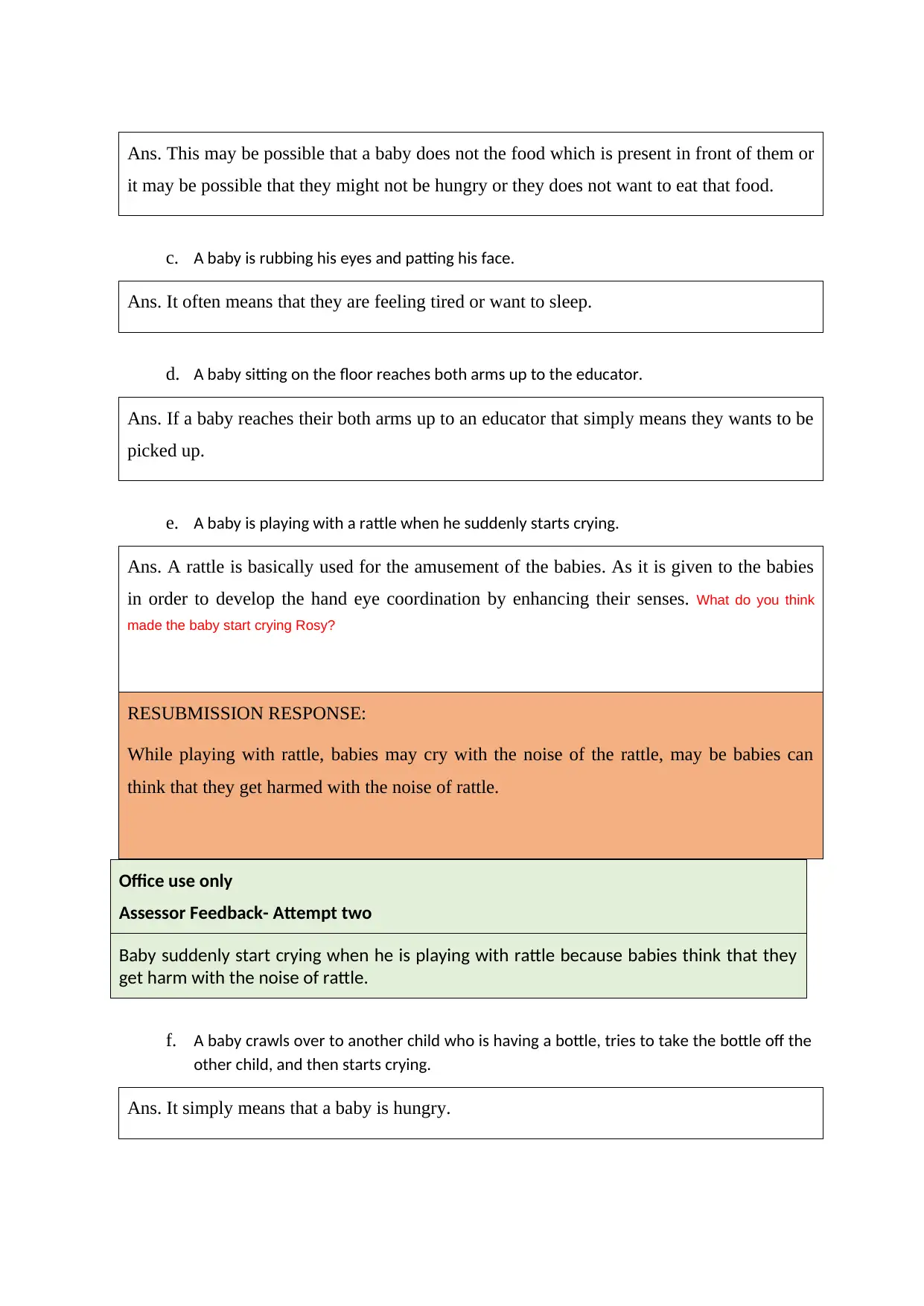
Ans. This may be possible that a baby does not the food which is present in front of them or
it may be possible that they might not be hungry or they does not want to eat that food.
c. A baby is rubbing his eyes and patting his face.
Ans. It often means that they are feeling tired or want to sleep.
d. A baby sitting on the floor reaches both arms up to the educator.
Ans. If a baby reaches their both arms up to an educator that simply means they wants to be
picked up.
e. A baby is playing with a rattle when he suddenly starts crying.
Ans. A rattle is basically used for the amusement of the babies. As it is given to the babies
in order to develop the hand eye coordination by enhancing their senses. What do you think
made the baby start crying Rosy?
RESUBMISSION RESPONSE:
While playing with rattle, babies may cry with the noise of the rattle, may be babies can
think that they get harmed with the noise of rattle.
Office use only
Assessor Feedback- Attempt two
Baby suddenly start crying when he is playing with rattle because babies think that they
get harm with the noise of rattle.
f. A baby crawls over to another child who is having a bottle, tries to take the bottle off the
other child, and then starts crying.
Ans. It simply means that a baby is hungry.
it may be possible that they might not be hungry or they does not want to eat that food.
c. A baby is rubbing his eyes and patting his face.
Ans. It often means that they are feeling tired or want to sleep.
d. A baby sitting on the floor reaches both arms up to the educator.
Ans. If a baby reaches their both arms up to an educator that simply means they wants to be
picked up.
e. A baby is playing with a rattle when he suddenly starts crying.
Ans. A rattle is basically used for the amusement of the babies. As it is given to the babies
in order to develop the hand eye coordination by enhancing their senses. What do you think
made the baby start crying Rosy?
RESUBMISSION RESPONSE:
While playing with rattle, babies may cry with the noise of the rattle, may be babies can
think that they get harmed with the noise of rattle.
Office use only
Assessor Feedback- Attempt two
Baby suddenly start crying when he is playing with rattle because babies think that they
get harm with the noise of rattle.
f. A baby crawls over to another child who is having a bottle, tries to take the bottle off the
other child, and then starts crying.
Ans. It simply means that a baby is hungry.
Paraphrase This Document
Need a fresh take? Get an instant paraphrase of this document with our AI Paraphraser
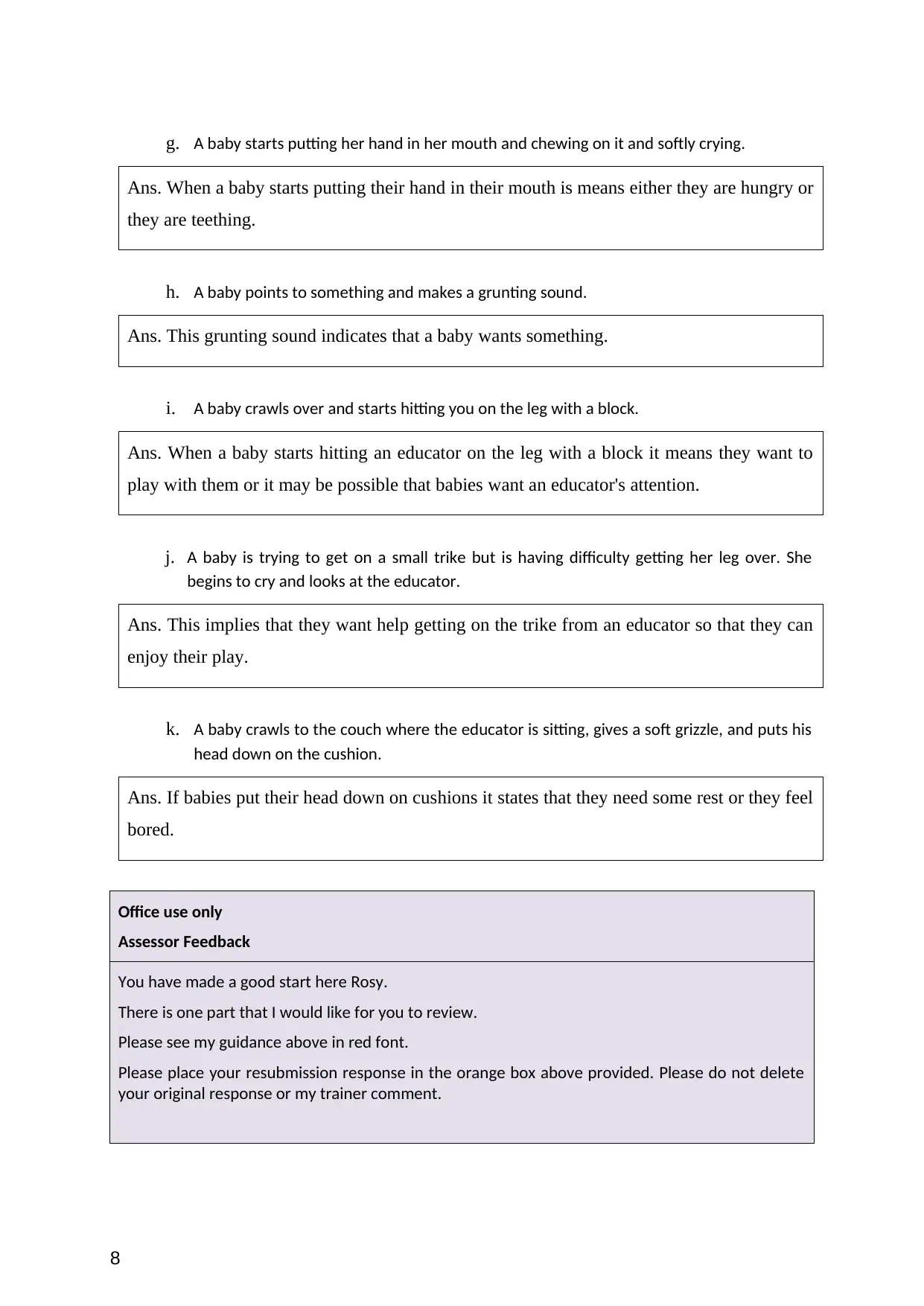
g. A baby starts putting her hand in her mouth and chewing on it and softly crying.
Ans. When a baby starts putting their hand in their mouth is means either they are hungry or
they are teething.
h. A baby points to something and makes a grunting sound.
Ans. This grunting sound indicates that a baby wants something.
i. A baby crawls over and starts hitting you on the leg with a block.
Ans. When a baby starts hitting an educator on the leg with a block it means they want to
play with them or it may be possible that babies want an educator's attention.
j. A baby is trying to get on a small trike but is having difficulty getting her leg over. She
begins to cry and looks at the educator.
Ans. This implies that they want help getting on the trike from an educator so that they can
enjoy their play.
k. A baby crawls to the couch where the educator is sitting, gives a soft grizzle, and puts his
head down on the cushion.
Ans. If babies put their head down on cushions it states that they need some rest or they feel
bored.
Office use only
Assessor Feedback
You have made a good start here Rosy.
There is one part that I would like for you to review.
Please see my guidance above in red font.
Please place your resubmission response in the orange box above provided. Please do not delete
your original response or my trainer comment.
8
Ans. When a baby starts putting their hand in their mouth is means either they are hungry or
they are teething.
h. A baby points to something and makes a grunting sound.
Ans. This grunting sound indicates that a baby wants something.
i. A baby crawls over and starts hitting you on the leg with a block.
Ans. When a baby starts hitting an educator on the leg with a block it means they want to
play with them or it may be possible that babies want an educator's attention.
j. A baby is trying to get on a small trike but is having difficulty getting her leg over. She
begins to cry and looks at the educator.
Ans. This implies that they want help getting on the trike from an educator so that they can
enjoy their play.
k. A baby crawls to the couch where the educator is sitting, gives a soft grizzle, and puts his
head down on the cushion.
Ans. If babies put their head down on cushions it states that they need some rest or they feel
bored.
Office use only
Assessor Feedback
You have made a good start here Rosy.
There is one part that I would like for you to review.
Please see my guidance above in red font.
Please place your resubmission response in the orange box above provided. Please do not delete
your original response or my trainer comment.
8
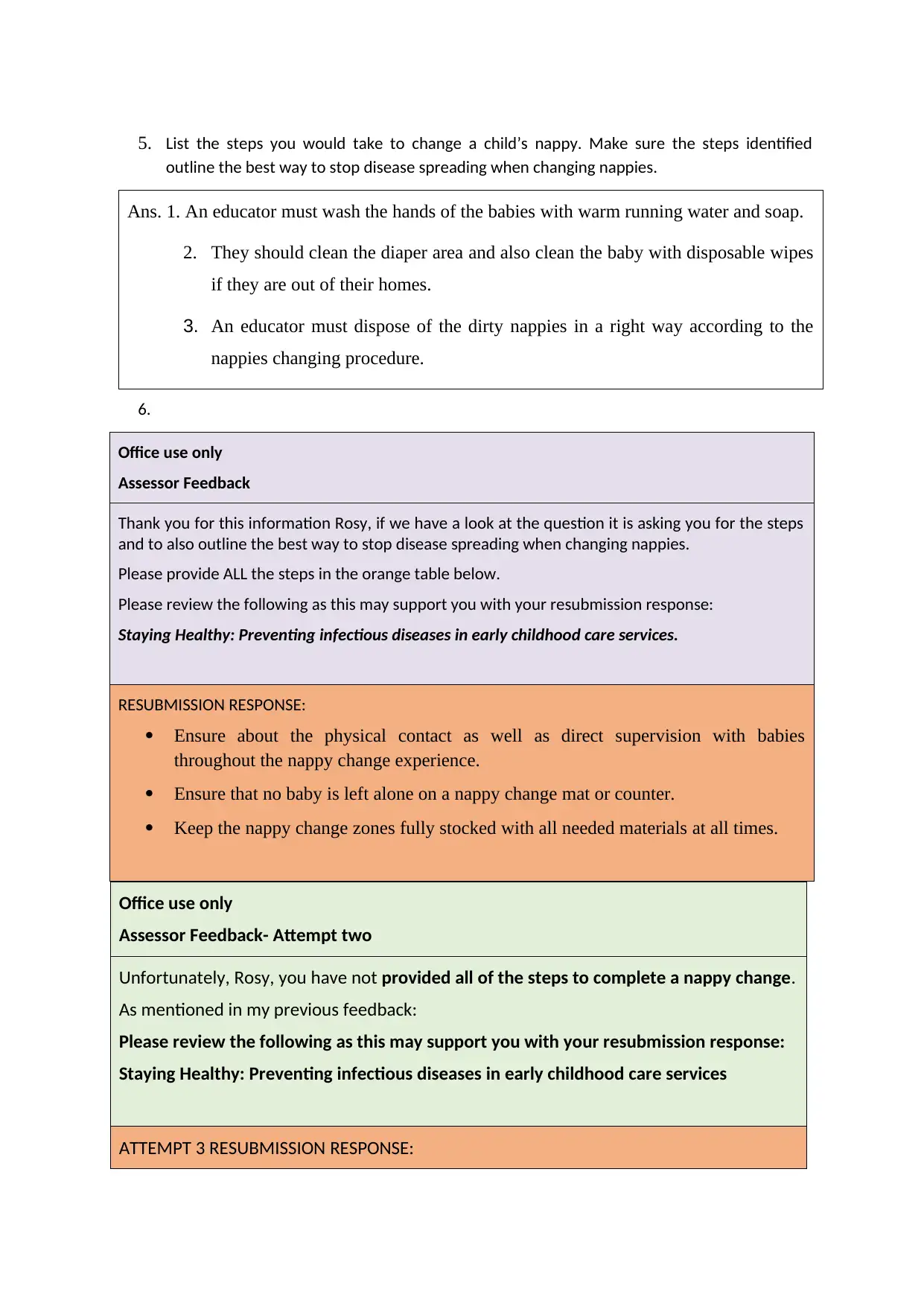
5. List the steps you would take to change a child’s nappy. Make sure the steps identified
outline the best way to stop disease spreading when changing nappies.
Ans. 1. An educator must wash the hands of the babies with warm running water and soap.
2. They should clean the diaper area and also clean the baby with disposable wipes
if they are out of their homes.
3. An educator must dispose of the dirty nappies in a right way according to the
nappies changing procedure.
6.
Office use only
Assessor Feedback
Thank you for this information Rosy, if we have a look at the question it is asking you for the steps
and to also outline the best way to stop disease spreading when changing nappies.
Please provide ALL the steps in the orange table below.
Please review the following as this may support you with your resubmission response:
Staying Healthy: Preventing infectious diseases in early childhood care services.
RESUBMISSION RESPONSE:
Ensure about the physical contact as well as direct supervision with babies
throughout the nappy change experience.
Ensure that no baby is left alone on a nappy change mat or counter.
Keep the nappy change zones fully stocked with all needed materials at all times.
Office use only
Assessor Feedback- Attempt two
Unfortunately, Rosy, you have not provided all of the steps to complete a nappy change.
As mentioned in my previous feedback:
Please review the following as this may support you with your resubmission response:
Staying Healthy: Preventing infectious diseases in early childhood care services
ATTEMPT 3 RESUBMISSION RESPONSE:
outline the best way to stop disease spreading when changing nappies.
Ans. 1. An educator must wash the hands of the babies with warm running water and soap.
2. They should clean the diaper area and also clean the baby with disposable wipes
if they are out of their homes.
3. An educator must dispose of the dirty nappies in a right way according to the
nappies changing procedure.
6.
Office use only
Assessor Feedback
Thank you for this information Rosy, if we have a look at the question it is asking you for the steps
and to also outline the best way to stop disease spreading when changing nappies.
Please provide ALL the steps in the orange table below.
Please review the following as this may support you with your resubmission response:
Staying Healthy: Preventing infectious diseases in early childhood care services.
RESUBMISSION RESPONSE:
Ensure about the physical contact as well as direct supervision with babies
throughout the nappy change experience.
Ensure that no baby is left alone on a nappy change mat or counter.
Keep the nappy change zones fully stocked with all needed materials at all times.
Office use only
Assessor Feedback- Attempt two
Unfortunately, Rosy, you have not provided all of the steps to complete a nappy change.
As mentioned in my previous feedback:
Please review the following as this may support you with your resubmission response:
Staying Healthy: Preventing infectious diseases in early childhood care services
ATTEMPT 3 RESUBMISSION RESPONSE:
⊘ This is a preview!⊘
Do you want full access?
Subscribe today to unlock all pages.

Trusted by 1+ million students worldwide
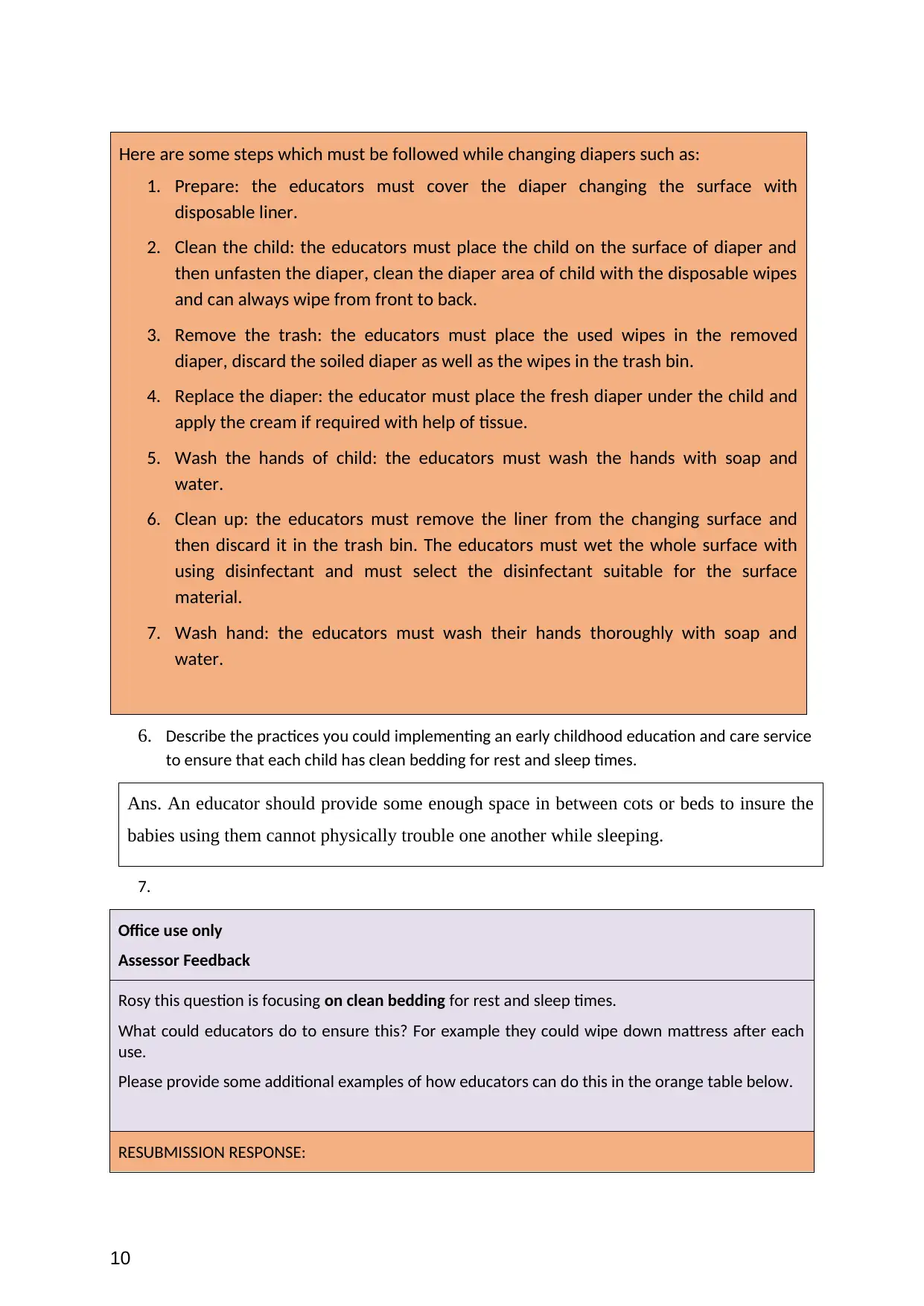
Here are some steps which must be followed while changing diapers such as:
1. Prepare: the educators must cover the diaper changing the surface with
disposable liner.
2. Clean the child: the educators must place the child on the surface of diaper and
then unfasten the diaper, clean the diaper area of child with the disposable wipes
and can always wipe from front to back.
3. Remove the trash: the educators must place the used wipes in the removed
diaper, discard the soiled diaper as well as the wipes in the trash bin.
4. Replace the diaper: the educator must place the fresh diaper under the child and
apply the cream if required with help of tissue.
5. Wash the hands of child: the educators must wash the hands with soap and
water.
6. Clean up: the educators must remove the liner from the changing surface and
then discard it in the trash bin. The educators must wet the whole surface with
using disinfectant and must select the disinfectant suitable for the surface
material.
7. Wash hand: the educators must wash their hands thoroughly with soap and
water.
6. Describe the practices you could implementing an early childhood education and care service
to ensure that each child has clean bedding for rest and sleep times.
Ans. An educator should provide some enough space in between cots or beds to insure the
babies using them cannot physically trouble one another while sleeping.
7.
Office use only
Assessor Feedback
Rosy this question is focusing on clean bedding for rest and sleep times.
What could educators do to ensure this? For example they could wipe down mattress after each
use.
Please provide some additional examples of how educators can do this in the orange table below.
RESUBMISSION RESPONSE:
10
1. Prepare: the educators must cover the diaper changing the surface with
disposable liner.
2. Clean the child: the educators must place the child on the surface of diaper and
then unfasten the diaper, clean the diaper area of child with the disposable wipes
and can always wipe from front to back.
3. Remove the trash: the educators must place the used wipes in the removed
diaper, discard the soiled diaper as well as the wipes in the trash bin.
4. Replace the diaper: the educator must place the fresh diaper under the child and
apply the cream if required with help of tissue.
5. Wash the hands of child: the educators must wash the hands with soap and
water.
6. Clean up: the educators must remove the liner from the changing surface and
then discard it in the trash bin. The educators must wet the whole surface with
using disinfectant and must select the disinfectant suitable for the surface
material.
7. Wash hand: the educators must wash their hands thoroughly with soap and
water.
6. Describe the practices you could implementing an early childhood education and care service
to ensure that each child has clean bedding for rest and sleep times.
Ans. An educator should provide some enough space in between cots or beds to insure the
babies using them cannot physically trouble one another while sleeping.
7.
Office use only
Assessor Feedback
Rosy this question is focusing on clean bedding for rest and sleep times.
What could educators do to ensure this? For example they could wipe down mattress after each
use.
Please provide some additional examples of how educators can do this in the orange table below.
RESUBMISSION RESPONSE:
10
Paraphrase This Document
Need a fresh take? Get an instant paraphrase of this document with our AI Paraphraser
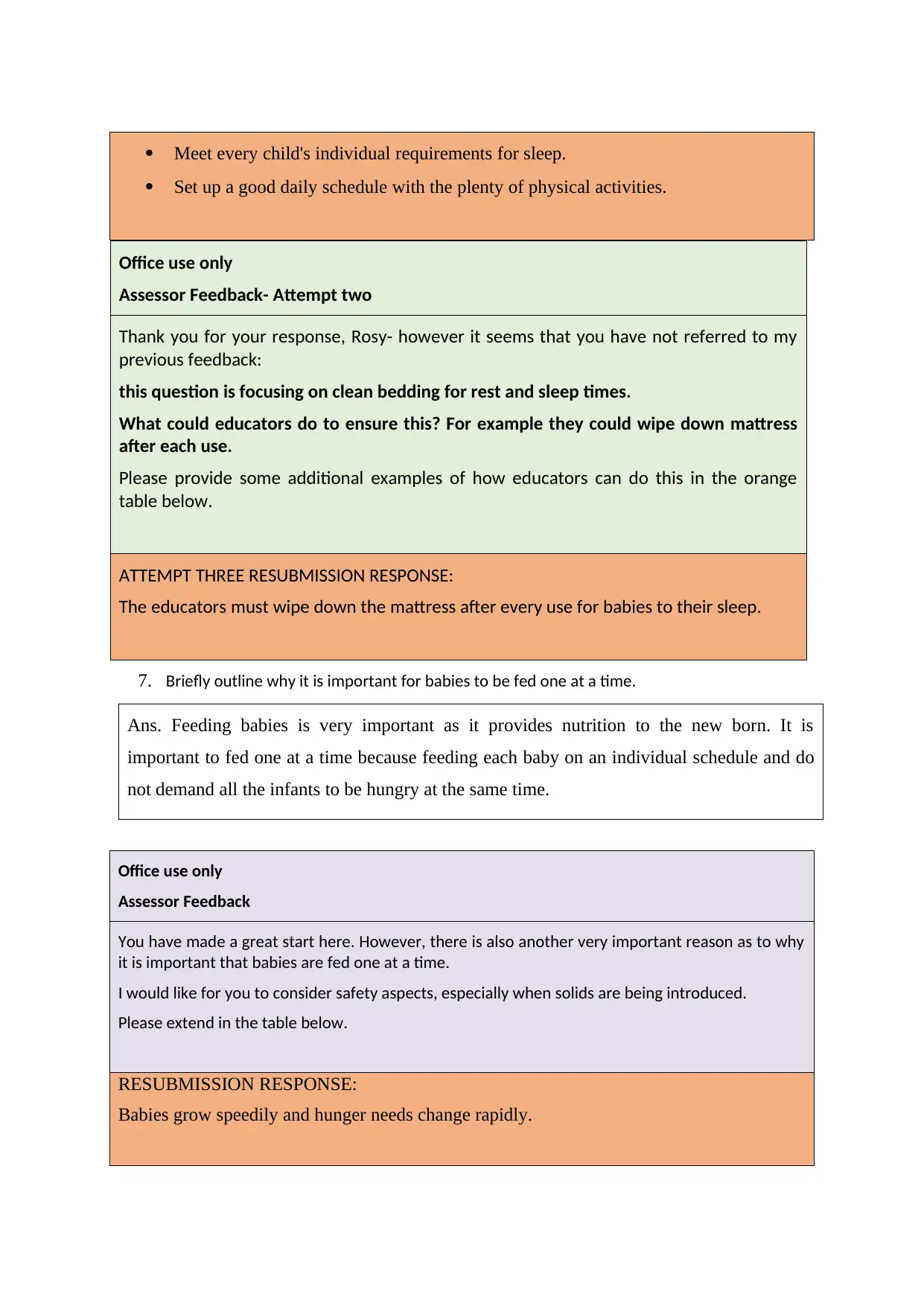
Meet every child's individual requirements for sleep.
Set up a good daily schedule with the plenty of physical activities.
Office use only
Assessor Feedback- Attempt two
Thank you for your response, Rosy- however it seems that you have not referred to my
previous feedback:
this question is focusing on clean bedding for rest and sleep times.
What could educators do to ensure this? For example they could wipe down mattress
after each use.
Please provide some additional examples of how educators can do this in the orange
table below.
ATTEMPT THREE RESUBMISSION RESPONSE:
The educators must wipe down the mattress after every use for babies to their sleep.
7. Briefly outline why it is important for babies to be fed one at a time.
Ans. Feeding babies is very important as it provides nutrition to the new born. It is
important to fed one at a time because feeding each baby on an individual schedule and do
not demand all the infants to be hungry at the same time.
Office use only
Assessor Feedback
You have made a great start here. However, there is also another very important reason as to why
it is important that babies are fed one at a time.
I would like for you to consider safety aspects, especially when solids are being introduced.
Please extend in the table below.
RESUBMISSION RESPONSE:
Babies grow speedily and hunger needs change rapidly.
Set up a good daily schedule with the plenty of physical activities.
Office use only
Assessor Feedback- Attempt two
Thank you for your response, Rosy- however it seems that you have not referred to my
previous feedback:
this question is focusing on clean bedding for rest and sleep times.
What could educators do to ensure this? For example they could wipe down mattress
after each use.
Please provide some additional examples of how educators can do this in the orange
table below.
ATTEMPT THREE RESUBMISSION RESPONSE:
The educators must wipe down the mattress after every use for babies to their sleep.
7. Briefly outline why it is important for babies to be fed one at a time.
Ans. Feeding babies is very important as it provides nutrition to the new born. It is
important to fed one at a time because feeding each baby on an individual schedule and do
not demand all the infants to be hungry at the same time.
Office use only
Assessor Feedback
You have made a great start here. However, there is also another very important reason as to why
it is important that babies are fed one at a time.
I would like for you to consider safety aspects, especially when solids are being introduced.
Please extend in the table below.
RESUBMISSION RESPONSE:
Babies grow speedily and hunger needs change rapidly.
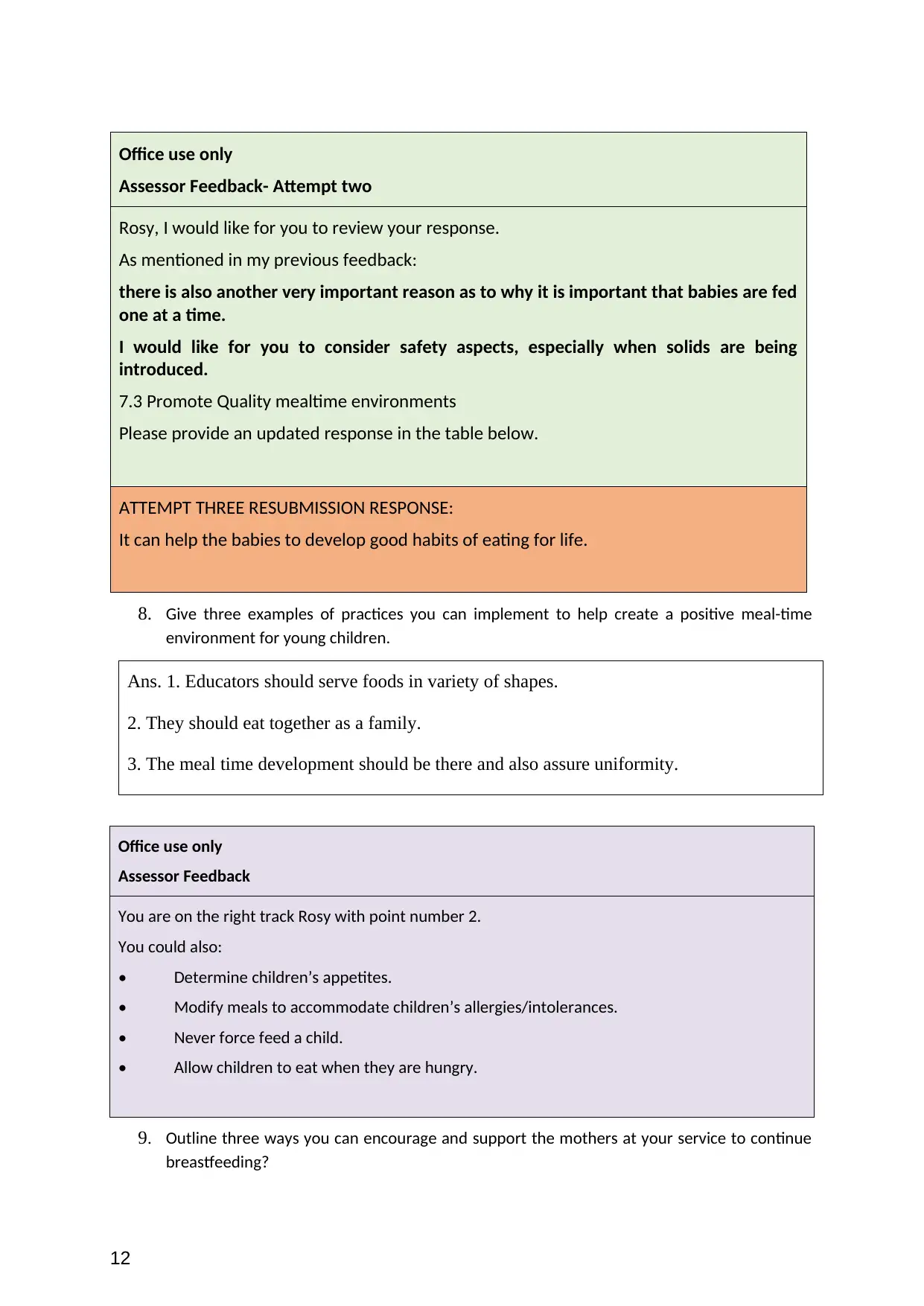
Office use only
Assessor Feedback- Attempt two
Rosy, I would like for you to review your response.
As mentioned in my previous feedback:
there is also another very important reason as to why it is important that babies are fed
one at a time.
I would like for you to consider safety aspects, especially when solids are being
introduced.
7.3 Promote Quality mealtime environments
Please provide an updated response in the table below.
ATTEMPT THREE RESUBMISSION RESPONSE:
It can help the babies to develop good habits of eating for life.
8. Give three examples of practices you can implement to help create a positive meal-time
environment for young children.
Ans. 1. Educators should serve foods in variety of shapes.
2. They should eat together as a family.
3. The meal time development should be there and also assure uniformity.
Office use only
Assessor Feedback
You are on the right track Rosy with point number 2.
You could also:
• Determine children’s appetites.
• Modify meals to accommodate children’s allergies/intolerances.
• Never force feed a child.
• Allow children to eat when they are hungry.
9. Outline three ways you can encourage and support the mothers at your service to continue
breastfeeding?
12
Assessor Feedback- Attempt two
Rosy, I would like for you to review your response.
As mentioned in my previous feedback:
there is also another very important reason as to why it is important that babies are fed
one at a time.
I would like for you to consider safety aspects, especially when solids are being
introduced.
7.3 Promote Quality mealtime environments
Please provide an updated response in the table below.
ATTEMPT THREE RESUBMISSION RESPONSE:
It can help the babies to develop good habits of eating for life.
8. Give three examples of practices you can implement to help create a positive meal-time
environment for young children.
Ans. 1. Educators should serve foods in variety of shapes.
2. They should eat together as a family.
3. The meal time development should be there and also assure uniformity.
Office use only
Assessor Feedback
You are on the right track Rosy with point number 2.
You could also:
• Determine children’s appetites.
• Modify meals to accommodate children’s allergies/intolerances.
• Never force feed a child.
• Allow children to eat when they are hungry.
9. Outline three ways you can encourage and support the mothers at your service to continue
breastfeeding?
12
⊘ This is a preview!⊘
Do you want full access?
Subscribe today to unlock all pages.

Trusted by 1+ million students worldwide
1 out of 38
Related Documents
Your All-in-One AI-Powered Toolkit for Academic Success.
+13062052269
info@desklib.com
Available 24*7 on WhatsApp / Email
![[object Object]](/_next/static/media/star-bottom.7253800d.svg)
Unlock your academic potential
Copyright © 2020–2025 A2Z Services. All Rights Reserved. Developed and managed by ZUCOL.





